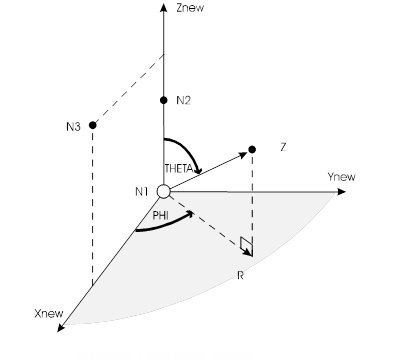Card 4c - New Local Coordinate System
This optional card creates a new coordinate system, using three previously defined nodes to define the orientation of its axes and the location of its origin.
Parameters: KODE, N1, N2,
N3
KODE
KODE = SCART (or
-2) creates a Cartesian coordinate system.

KODE = SCYL (or -3) creates a
cylindrical coordinate system.

KODE = SSPHER (or -4) creates a
spherical coordinate system.

N1
N1 parameter is a previously defined node, where the origin of the new coordinate system is located.
N2
N2 parameter is a previously defined node, which lies along the new Z axis.
N3
N3 parameter is a previously defined node, which lies in the new XZ plane, on its +X side (e.g., along the new +X axis).
Code example
–1
$ STARTING CARD 4 DATA
$
1 1.0 0.0 0.0 $ THESE 3 NODES ARE USED TO DEFINE THE NEW LOCAL
2 1.0 0.0 1.0 $ COORDINATE SYSTEM. BY DEFAULT THEY ARE IN THE
3 2.0 0.0 0.0 $ GLOBAL CARTESIAN COORDINATE SYSTEM.
$
$ THE NEXT CARD 4C CREATES A NEW CYLINDRICAL COORDINATE
$ SYSTEM WHOSE ORIGIN LIES AT (1.0 0.0 0.0) OF THE
$ GLOBAL COORDINATE SYSTEM AND WHOSE AXES ARE PARALLEL
$ TO THE AXES OF THE GLOBAL COORDINATE SYSTEM.
$
SCYL 1 2 3
$
$ THE NEXT CARD IS A NODE IN THE NEW CYLINDRICAL
$ COORDINATE SYSTEM, WITH COORDINATES R = 2, PHI = 45,
$ Z = 1. THE COORDINATES OF THIS NODE IN THE GLOBAL
$ COORDINATE SYSTEM WILL BE(2.414, 1.414, 1.0).
$
4 2.0 45.0 1.0
-1Notes
This card creates a new coordinate system, using three previously defined nodes to define the orientation of its axes and the location of its origin. All node Cards following this Card will be in the new coordinate system, until a new Card 4c is encountered. The default is the Cartesian global coordinate system.
If N1, N2, and N3 are all blank, the location of the origin and the orientation of the new local coordinate system are not altered from their current value, only the type of the coordinate system changes, depending on the value of KODE.
